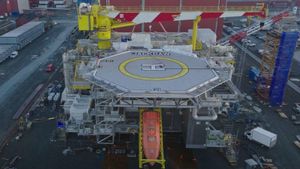DeepSeek, a new artificial intelligence model from China, is sending shockwaves through the investment strategies of tech giants and reigniting competition concerns. This week, Wall Street was gripped by worries over DeepSeek’s potential to upend long-held AI spending strategies, as news broke of this groundbreaking model developed at what many deem impossibly low costs. Yet, as the dust settled, major players like Microsoft and Meta stood firm on their ambitious AI investments, arguing the new model might actually spur growth rather than hinder it.
DeepSeek’s R1 model reportedly costs around $6 million to develop—far less than competing models being produced by industry leaders like OpenAI and Nvidia. This cost efficiency raised eyebrows, casting doubt on the necessity for the billions of dollars traditionally earmarked for AI infrastructure. Many tech stocks took a hit as the market reacted to fears of diminished profit margins.
On one hand, the launch spurred anxiety, with shares of chipmakers Nvidia and Broadcom plummeting about 17% on report of DeepSeek’s cost-effective creation, causing significant losses and wiping $800 billion off the market’s valuation. On the other hand, executives at the top tech firms describe this shift as potentially beneficial. Microsoft CEO Satya Nadella, for example, emphasized how cost reductions can lead to increased demand during the company’s recent earnings call.
"What’s happening with AI is no different than what was happening with the regular compute cycles," Nadella stated, highlighting the relationship between cost efficiency and AI scaling. He went on to note, "as AI computing prices fall, more applications will emerge, leading to greater demand for infrastructure to host these initiatives." Microsoft plans to invest $80 billion over the fiscal year 2025, indicating no plans to diminish its spending based on DeepSeek’s innovations.
Meta also reaffirmed its commitment to artificial intelligence by announcing plans to invest between $60 billion and $65 billion this year alone. CEO Mark Zuckerberg mentioned the need to adapt to advances made by DeepSeek, hinting at the competitive nature of the tech industry. "It’s probably too early to really have strong opinions on what this means for our infrastructure and capital expenditure going forward," he remarked on the earnings call, noting the dynamic shifts within AI innovation.
While many firms view DeepSeek through the lens of competition, others are assessing how it could be used to their advantage. Apple CEO Tim Cook took the opportunity to refer to the efficiencies driven by innovation, stating, "Innovation driving efficiency is good. That’s what you see with this model." This was met with cautious optimism from other tech leaders as well, who perceive opportunities arising from DeepSeek's release.
Meanwhile, various executives from across the tech sector are aware of the overarching significance of AI as the defining technology for the future. Palantir CEO Alex Karp emphasized on CNBC, "We have to acknowledge the potential risks technology poses, but this also means we must run harder and faster. It's about creating a comprehensive effort across countries to maintain competitiveness." These sentiments echo the urgency seen among U.S. firms since the emergence of DeepSeek.
DeepSeek's rapid ascension within the industry spotlighted the urgent need for U.S. firms to reassess their strategies. This observation isn't lost on OpenAI's CEO Sam Altman, who characterized R1 as “clearly a great model” and encouraged American companies to regard its innovations as invigorations rather than threats.
He said, "We need to push forward with the development of even more advanced models. This is not time for panic; it's about invigorated competition. There’s much to learn from what DeepSeek is achieving." On the flip side, skepticism remains. A new report from research firm SemiAnalysis speculated DeepSeek's historical costs to be considerably higher than initially reported, provoking questions about the sustainability of such low-cost productions.
Overall, the sense within the tech industry is one of cautious optimism. Company analysts and leaders alike acknowledge the existence of several concurrent trends, and the immediate future shows continued focus on investments. Judging by the responses from Microsoft and Meta, the AI investment train isn’t slowing down. With DeepSeek's cost efficiencies and breakthroughs, leaders are invigorated, committed to enhancing capabilities.
Indeed, DeepSeek may signal the start of another wave of competition, but it hasn't turned the tide against established players just yet. Whether this low-cost model can hold up under scrutiny remains to be seen, but what’s certain is the industry will watch closely, seeking to capitalize on any openings or innovations within this rapidly changing framework.



